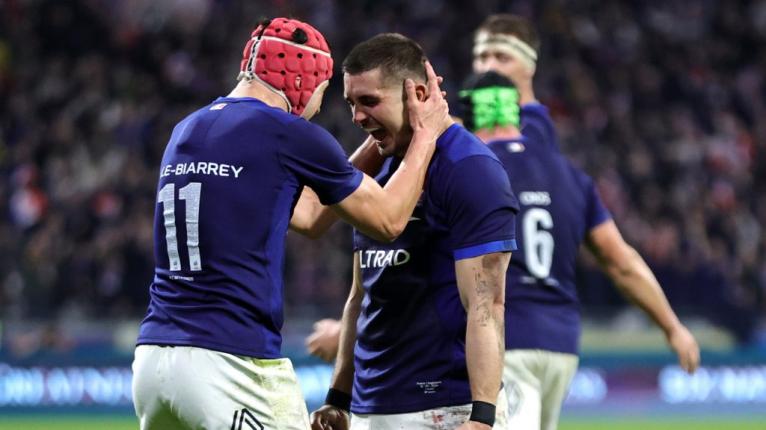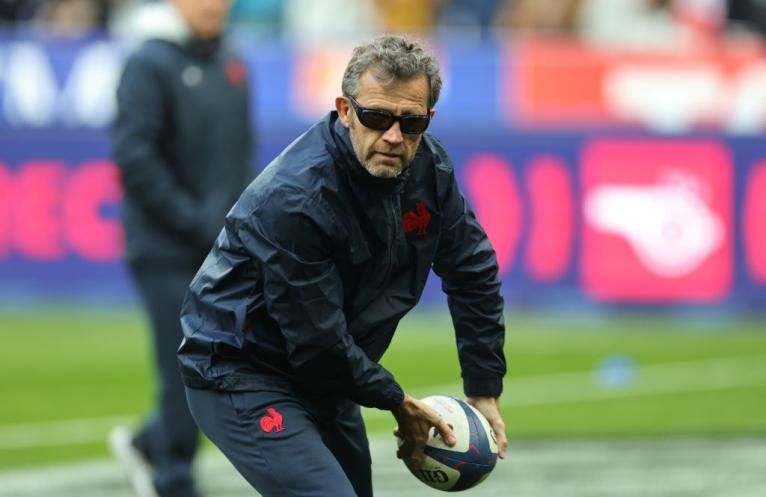[ad_1]
What a fickle lot we rugby writers are. It was only three weeks ago a grisly post-mortem was being performed on the corpse that was the French national team. Alongside photographs of coach Fabien Galthie looking glummer than usual, journalists and pundits cast a pessimistic eye over a French squad which had been trounced by Ireland, sneaked a controversial victory over Scotland and stumbled to a draw at home to Italy. ‘Garbled message, slapdash rugby,’ was one headline in Midi Olympique.
A couple of weeks later the front page of the same newspaper was emblazoned with the headline ‘All Smiles’, above a photo of the French team celebrating their victory over England in the final match of the Six Nations.
It was a win that earned France a runners-up spot in the table behind champions Ireland. Did France deserve that position? Not really. Had the TMO decided Scotland’s Sam Skinner had touched the ball down over the try line, France would have lost at Murrayfield, and had Italy’s Paolo Garbisi last-second penalty kick sneaked inside the post instead of hitting it France would have gone down to the Azzurri. And had Ben Earl not conceded that last-second penalty in Lyon…
In other words, while Ireland were convincing winners France were largely unconvincing throughout. Even their 45-21 win in Cardiff was not as emphatic as the scoreline suggests; France led Wales by three points at the break and only pulled away in the final quarter when their behemoths came off the bench to overpower the hosts.
But enough of the churlishness. The win against Wales and particularly the defeat of England laid to rest for France the ghost of the World Cup. Their quarter-final loss to South Africa still haunted France when this year’s championship began. It was in the players’ eyes, that crushing disappointment, that bitter anti-climax they endured in Paris.
Galthie’s mistake was to stay loyal to the World Cup squad; the bulk of the team that lost to Ireland was the same which had lined up against South Africa, minus Antoine Dupont who was off playing sevens on the west coast of America.
Jonathan Dany has struggled this season to reach the heights of 2022, and his power and pace (and his discipline) are on the wane. He may not be seen again in a French shirt.
Some wanted Dupont brought back, others wondered whether Shaun Edwards should be sacked. Such was the panic in France.
Galthie sent his squad home after the Italy match. Have a week off, he told them, you need it. Several had their rest extended as Galthie brought in fresh reinforcements for the visit to Cardiff.
If others in France were panicking after the draw against Italy, Galthie kept his cool and he also benefited from two strokes of good fortune, though the players concerned wouldn’t see it that way.
The first was the injury to Matthieu Jalibert, the fits-and-starts Bordeaux fly-half, who hobbled off against Italy with knee damage and was ruled out for the rest of the tournament.
That forced Galthie to move Thomas Ramos to fly-half. Five years ago I went down to Toulouse to interview Ramos in the company of Dupont and Romain Ntamack. Dupont was the most confident, Ntamack the quietest and Ramos the most serious. There was a steely determination about him, a man with a plan, as they say. He’d bought a house and was doing it up, that’s how he spent his spare time.

If Dupont and Ntamack burst onto the international scene with explosive brilliance, Ramos’s Test career has been more of a slow burner. Nine of his first 15 caps came off the bench, and he appeared at full-back, on the wing and in the centre.
After the injury to Jalibert, Galthie moved Ramos from full-back to fly-half for the trip to Cardiff. It transformed France. Ramos not only reads the game expertly, he has ice in his veins; in temperament he’s probably the closest fly-half France have had to Jonny Wilkinson.
He scored 20 points against Wales and 18 against England, including the winning penalty when every bum in the stadium was at its squeakiest. ‘Nerves of steel,’ as Imanol Harinordoquy said. ‘Ramos has become the real boss of the French XV. He brings his influence to bear on the game and on his teammates.’
Moving Ramos from 15 to 10 meant Galthie required a new full-back, and he selected 21-year-old Léo Barré for his first cap.
Physically, Barré is in the mould of England’s Freddie Steward; he is also solid in defence, especially under the high ball, with a powerful boot. The difference is in attack where the Frenchman has the pace and acceleration Steward lacks.
Their tussle for the scrum-half shirt next season will be box-office; it’s hard to see Le Garrec relegating the imperious Dupont to understudy.
The other lucky break for Galthie was the suspension of Jonathan Danty, sent off against Italy for a head-on-head tackle. The 31-year-old La Rochelle centre has struggled this season to reach the heights of 2022, and his power and pace (and his discipline) are on the wane. He may not be seen again in a French shirt.
Galthie called up another rookie 21-year-old: Bordeaux’s Nicolas Depoortère, who normally plays at 13 for his club. He moved to inside centre alongside Gael Fickou and while there were positional errors in defence against Wales and England, there was evidence of his offensive potential.
There were eight changes in all for the trip to Wales, positional or in personnel, and Galthie’s gamble paid off handsomely, as it did against England. No one impressed more than scrum-half Nolann Le Garrec, yet another of the ‘21 club’, who, whatever happens in the rest of his career, will forever be remembered for his outrageous reverse pass across the width of the Principality Stadium pitch. The French call this type of pass a ‘chistera’, the name of the gloves used in the popular Basque sport of pelota. There is a pendulum movement of the arms when playing pelota that is similar to rugby’s reverse pass.
Le Garrec is unusual for a French international in that he comes from Brittany, whereas most of the squad come from the south, the heartlands of French rugby. In that respect he couldn’t be more different from Dupont, who hails from a village in the Pyrénées, 400 miles south. Asked after the Wales game if he wished he’d been born in another era so he wouldn’t have to compete with Dupont for the number nine shirt, Le Garrec replied: ‘I don’t think about that…Antoine Dupont pulls us all towards the top and watching him I’m inspired to try and reach his level’.

Their tussle for the scrum-half shirt next season will be box-office; it’s hard to see Le Garrec relegating the imperious Dupont to understudy but, worryingly for France’s rivals, the rivalry might push the Toulouse scrum-half to new heights.
Between now and then, France play two Tests in Argentina in July, an opportunity for Le Garrec and the ’21 club’ to gain more international experience. Galthie will take a squad of 42 on tour but players from the two teams who contest the Top 14 final on 28 June will not be available. Presumably, Galthie will also leave out many of the players who saw action in the World Cup.
Among the youngsters who will go to Argentina are Perpignan’s giant lock Posolo Tuilagi, the equally hefty La Rochelle prop Georges-Henri Colombe, Pau centre Émilien Gailleton and the Bordeaux hooker Maxime Lamothe. Galthie will surely secretly be hoping Toulouse don’t reach the Top 14 final; if they do he’ll be deprived of lock Emmanuel Meafou, one of the eight changes for the Wales game, utility forward Alexandre Roumat, centre Pierre-Louis Barassi and number eight Mathis Castro-Ferreira.
France, then, are in a good place. That hammering at home to Ireland feels like a long time ago, as does the embarrassing draw against Italy. The French are once again world-beaters and we hacks are as fickle as ever.
[ad_2]
Source

Leave a Reply